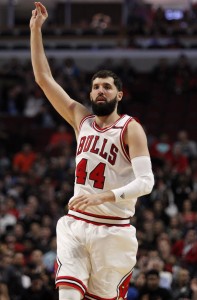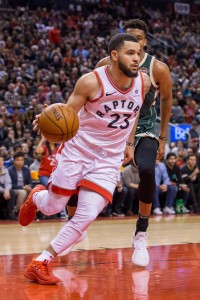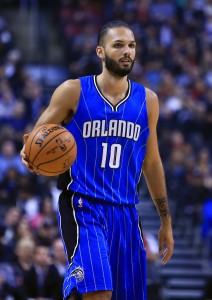Only two NBA players – LeBron James and Carmelo Anthony – technically have no-trade clauses included in their current contracts. However, there are several players around the league with the ability to block trades that would involve them.
A player who re-signs with his previous team on a one-year contract – or a two-year deal with an option year – is given no-trade protection, and so is a player who accepts his qualifying offer after his rookie deal expire. If one of those players is dealt, he’d lose his Bird or Early Bird rights, which is a key reason he must approve a move.
A player who signed an offer sheet and had that offer matched by his previous team can also veto trades, and can’t be sent to the team that attempted to sign him during that same league year. That means, for instance, that the Wizards can’t trade Otto Porter to the Nets this season.
There are 17 players around the NBA that meet one of those criteria, bringing the number of players with a no-trade clause – either official or unofficial – to 19. While most of those players probably aren’t going anywhere at the trade deadline anyway, there are a handful of trade candidates who would have to consent to a move, creating an added wrinkle as those players’ teams consider their trade options.
Here are some notable players whose consent is required in order to trade them:
 Nikola Mirotic, PF (Bulls): We’ve covered Mirotic’s unofficial no-trade clause many times over the last few weeks, but it’s worth noting that his situation is a little different than anyone else’s on this list. Mirotic’s contract is actually a two-year pact, with a team option for the second year. So while he has veto power for now, that would disappear if the Bulls were to pick up his $12.5MM option for 2018/19. If the Bulls find a trade they like for Mirotic, he could use his veto power as leverage, pushing the club to exercise that option. And he might get his wish — any team willing to give up something of value for the veteran forward might not mind locking him in for an extra year as part of the deal.
Nikola Mirotic, PF (Bulls): We’ve covered Mirotic’s unofficial no-trade clause many times over the last few weeks, but it’s worth noting that his situation is a little different than anyone else’s on this list. Mirotic’s contract is actually a two-year pact, with a team option for the second year. So while he has veto power for now, that would disappear if the Bulls were to pick up his $12.5MM option for 2018/19. If the Bulls find a trade they like for Mirotic, he could use his veto power as leverage, pushing the club to exercise that option. And he might get his wish — any team willing to give up something of value for the veteran forward might not mind locking him in for an extra year as part of the deal.- Nerlens Noel, C (Mavericks): As we noted on Thursday when we identified Noel as a trade candidate in the Southwest, the young center’s value is complicated by the fact that he’s currently sidelined with a thumb injury. Noel may be back in early February though, in which case potential suitors would have a chance to see if he’s healthy before pursuing a deal. The union between Noel and the Mavericks has been a rocky one, and it seems unlikely to turn into a long-term relationship, so if Dallas finds a taker for the 23-year-old, I expect he’d sign off, even if it means losing his Bird rights — those Bird rights probably won’t matter much this offseason if the Mavs don’t plan to retain him.
- Alex Len, C (Suns): Like Noel, Len had trouble finding an offer sheet on the restricted free agent market last summer and ultimately signed his qualifying offer. Unlike Noel though, Len has had a regular role and a solid year, averaging 8.5 PPG with career highs in RPG (8.3) and FG% (.552). The Suns have a bit of a logjam in the middle, and Len might have more trade value than Greg Monroe or Tyson Chandler, but Monroe is on an expiring contract and Chandler is 35 years old, making them more expendable for the rebuilding Suns. In other words, even though he’ll be a free agent again in July, Len remains the center most likely to stick in Phoenix for the next several years. I don’t expect the team will ask him to approve a trade.
- Ersan Ilyasova, PF (Hawks): The Hawks are reportedly seeking a high second-round pick in exchange for Ilyasova, and that price doesn’t seem unreasonable for a productive stretch four on an affordable contract, even if that contract will expire this summer. While Ilyasova may hesitate to surrender his Bird rights by approving a trade, those Bird rights aren’t as valuable to him as they would be to a star player, since Ilyasova is unlikely to earn more than the mid-level in free agency. The veteran sharpshooter has also led a nomadic NBA existence in recent years, playing for five different teams since the start of the 2015/16 season, so he’s accustomed to bouncing around and may not mind leaving the 13-31 Hawks to join a contender.
- Shabazz Muhammad, SF (Timberwolves): Muhammad hasn’t been mentioned in any trade rumors yet, but he can’t be thrilled with the way this season has played out for him in Minnesota. After failing to find a lucrative deal on the free agent market in the offseason, the 25-year-old accepted a one-year, prove-it deal from the Timberwolves, and has fallen out of the rotation over the course of the season — he has played just 17 minutes since the start of December. Muhammad isn’t a great defender or distributor, and he has been ineffective as a scorer this season (.376/.211/.750 shooting), so he’ll have little to no trade value. Still, he’s only earning the minimum, so there may be a team willing to roll the dice. It’s also worth mentioning that Muhammad’s deal includes a player option for 2018/19, which may be a minor motivating factor for the Wolves to explore a deal rather than keeping him around for depth purposes — the team’s roster will get more expensive next season, so removing even a modest amount of potential guaranteed money for a non-essential player could help.
Photo courtesy of USA Today Sports Images.



